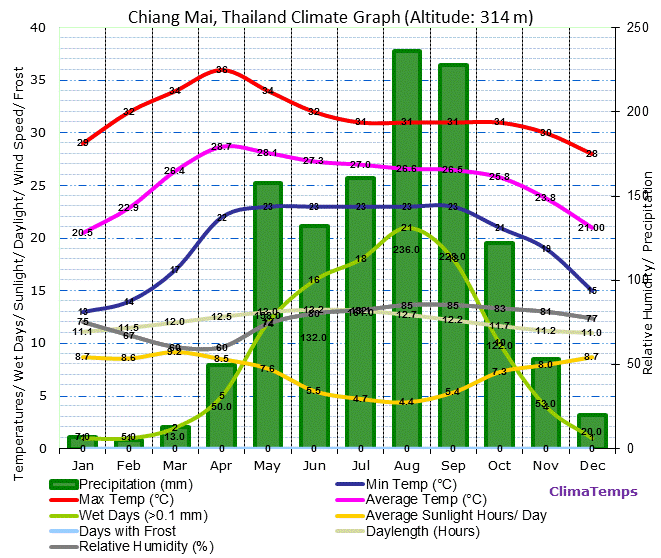Chiang Mai (or Thailand’s “Rose of the North”) is the major destination in the northern Thailand. This northern city is a cultural and natural wonderland with ethnic diversity, a multitude of attractions and welcoming hospitality. Think jungle and elephant rides, temples, and culture. There are many interesting temples worth visiting, both in the city and the surrounding area. The city is also known for its crafts, making the Craft Villages a must for a little shopping.
Chiang Mai literally means “new city” and has retained the name despite celebrating its 700th anniversary in 1996. King Meng Rai the Great founded the city as the capital of the Lanna Kingdom on Thursday, April 12 1296 around the same time as the establishment of the Sukhothai Kingdom. King Meng Rai even conferred with his friends, King Ramkhamhaeng of Sukhothai and King Ngam Muang of Phayao before choosing the site where the capital of the Lanna Kingdom was to be founded. Henceforth, Chiang Mai not only became the capital and cultural core of the Lanna Kingdom, it was also to be the center of Buddhism in northern Thailand. King Meng Rai himself was a very religious leader who even founded many of the city’s temples that remain important to this day. Chiang Mai is one of the few places in Thailand where it is possible to experience both historical and modern Thai culture coexisting side by side: the city features centuries-old pagodas and temples next to modern convenience stores and boutique hotels. This dichotomy is best appreciated within the moat-encircled old city, which retains much of the fortified wall that once protected the city center as well as the four main gates that provided access to the former Lanna capital city.
Strangely, for many years tourists had mistaken Chiang Mai simply as the base from which they could plan trekking and rafting trips to hill tribe villages and explore other provinces. Once in Chiang Mai, however, tourists are surprised by the fact that there are so many things to discover other than its beautiful and historic temples. Intriguing diversity among ethnic tribes, a number of elephant camps, many cooking and massage schools, numerous outdoor activities, a variety of handicrafts workshops, various cultural performances, and breathtaking scenery make Chiang Mai one of Asia’s most attractive tourist destinations. The phrase “a day in Chiang Mai is enough to see things around town” was once a common expression. Today, two weeks in Chiang Mai may not be long enough for travelers to experience all that Chiang Mai has to offer. For more information, you can also visit Tourism Thailand Website or visit Wikipedia.
Source: Tourism Thailand Website, Wikipedia, and Planetware
Climate and Temperature
Chiang Mai has a tropical wet and dry/savanna climate with a pronounced dry season in the low-sun months , no cold season, wet season is in the high-sun months. According to the Holdridge life zones system of bioclimatic classification Chiang Mai is situated in or near the subtropical moist forest biome.
The mean annual temperature is 25.4 °C (77.7 °F). Average monthly temperatures vary by 8.2 °C (14.8 °F). This indicates that the continentality type is hyperoceanic, subtype barely hyperoceanic. For more information, please visit Chiang Mai Climate & Temperature Website.
Source: Chiang Mai Climate & Temperature
Or click here to see Today weather forecast.


